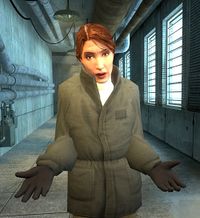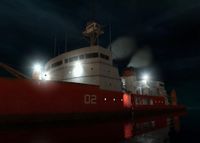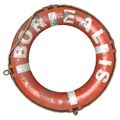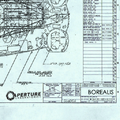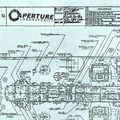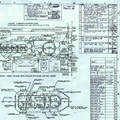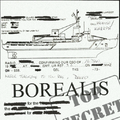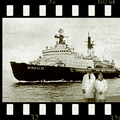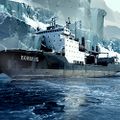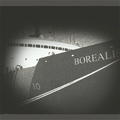Borealis (Aperture Science ship)
This article is about the Aperture Science ship. For the location cut from Half-Life 2, see Borealis (cut ship). For the cancelled VR game see Borealis (cancelled game). |
| | |
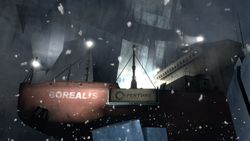
| |
| Borealis | |
|---|---|
| General information | |
| Era(s) | |
| Faction | |
| Type |
Research icebreaker |
| Built |
20th century[1] |
| Location |
Stranded in the ice in an undefined Arctic location[2] |
| Used by |
Aperture Science researchers |
| Game information | |
| Map(s) |
|
| Designer(s) |
|
- "Our peers at Aperture Science were at work on a project of some promise, but in their rush to beat Black Mesa for funding, they must have compromised ordinary standards of risk. We heard their research vessel had simply disappeared. Vanished - with all hands... and even part of the dry dock!"
- ― Isaac Kleiner[src]
The Borealis is an Aperture Science research icebreaker of an almost legendary stature[2] introduced in Half-Life 2: Episode Two. It is implied that it contains an immensely powerful and dangerous secret, yet to be revealed.
Contents
Background[edit]
The Borealis is a former United States Coast Guard Healy-class icebreaker that was later acquired by Aperture Science. Aperture used the ship to work on a massive project for a competing bid against Black Mesa over a Defense Logistics Agency contract for an effective FSII solution. Although events surrounding the ship are highly classified, it is known that it disappeared in its entirety during testing and development.[3]
Appearances[edit]
Half-Life 2: Episode One[edit]
- “I'm fairly sure I've pinned down the location of the Project. It's hard to say how much of it might have survived intact, or whether there's anything remaining that could compromise our work... if it were discovered by the Combine. We'll need to take a close look at it, of course, but I should be able to give a better opinion within a few hours. If the site is where we think it is, then it should be no more than... I'm going to cut this short. We may have been spotted.”
- — Dr. Mossman[2]
Many years after the Combine invasion of Earth, Judith Mossman, Resistance operative, finds the Borealis in an Arctic location. She is attacked by Combine forces soon after and is only able to send an incomplete transmission of her discovery to White Forest. This transmission is intercepted by the Combine and is in turn stolen back by Gordon Freeman and Alyx Vance from the Citadel Core during their flight from City 17.
Half-Life 2: Episode Two[edit]
After safely reaching White Forest, Alyx and Gordon deliver the data to the Resistance which reveals that Mossman was cunning enough to encrypt Borealis photographs, coordinates, blueprints, and hailing frequencies within her message. Once Eli Vance and Isaac Kleiner have decoded these and realize the full significance of the transmission, a rift opens between the two Resistance leaders. Kleiner believes the technology the Borealis contains could be used by the Resistance against the Combine; Eli, haunted by memories of the Black Mesa Incident and not wanting a second Seven Hour War, believes that the Borealis has to be destroyed at all costs. He also believes that the warning delivered to him by the G-Man through Alyx, "prepare for unforeseen consequences," is about the ship.
It is not clear whether the Combine are yet aware of the Borealis and consequently if they themselves have interest in the ship's power.
Portal 2[edit]
In Portal 2, during the chapter The Fall, a large dry dock for the Borealis can be found in the 1970s section of Test Shaft 09 near the offices where Chell finds GLaDOS in the bird's nest. The dock is completely empty, save for several life preservers bearing the ship's name scattered on the floor.
Unlike other rooms in the same area, this room was not vitrified (however the door has the word 'Vitrified' written on it, which can be seen by noclipping under it). In fact, the large bulkhead door has been blasted straight out of its hinges. There is no gate or exit of any sort through which the Borealis could have been entered or exited the room, so it can be assumed it teleported out, perhaps through some violent portal event. Kleiner says in Episode Two that the ship disappeared with parts of its dry dock; he likely refers to the scaffolding, cranes, or other similar machinery as the dry dock itself appears intact.
Future[edit]
As suggested by the end of Episode Two, the Borealis is expected to be the focal point of a future Half-Life game. Of the three pieces of Episode Three concept art released from 2007 to 2008, two feature the Borealis entrenched in ice, covered in Combine technology, and flanked by Advisors, suggesting the Combine will have an established presence around the ship.
Related Achievements[edit]
| Portal 2 | |
|---|---|

|
Ship Overboard (10G) |
| Discover the missing experiment. | |
Behind the scenes[edit]
The icebreaker Borealis was originally to appear in Half-Life 2 as the Hyperborea, then the Borealis. In one of the earliest versions of the story, Gordon was to start the game by boarding the ship.[4] Later in the game's development, it was to appear between two other cut chapters, the Air Exchange and Kraken Base,[5][6] before being eventually cut along with the rest of the plot set between the Depot and the City 17 uprising.
The original ship was based on the real world USCGC research icebreaker the Polar Star. However, the design of the ship seen in Episode 2 is based on the USCGC Healy rather than the Polar Star. The reason for the change is unknown.
The name "Borealis" is likely associated with the term "aurora borealis", the northern polar lights only visible in the Northern Hemisphere. "Borealis" comes from "Boreas", a wind god in the Greek mythology. "Hyperborea", the early name for the ship, was the name of the land of the Hyperboreans, a mythical people who lived far to the north of Thrace. "Hyperborea" means "beyond the Boreas", thus beyond the land of the wind god Boreas.
The Borealis's teleportation mishap shares many similarities to the urban legend of the Philadelphia Experiment in which the warship USS Eldridge was rumored to have been rendered invisible by experimental technology. In some versions of the story, the ship had accidentally teleported from its dry dock to a U.S. naval base over 200 miles away. In the most radical versions of the story, the ship achieved accidental time travel. When Marc Laidlaw was asked about it, he stated that he had it in his mind from way back.[7]
The images hidden in Mossman's message are located in the Episode Two texture files in the folders effects and props. Inspection of the textures reveals additional elements not visible during their in-game appearance, including some unused images. One of these images shows two of the unknown scientists in Kleiner's Black Mesa Anomalous Materials team photograph, a bearded man and a woman, posing in front of the Borealis. Other images include three blueprints of the Borealis. The real world ship blueprints used here are not for any of the previously mentioned United States Coast Guard research icebreakers but rather those of a naval warship, the USS Newport News, a United States Navy heavy cruiser launched after World War II. They also feature tables taken from other blueprints. The images also show a QSL card for the USCGC Polar Star. Additional text indicates the presence of at least a Material Emancipation Grill and an Unstationary Scaffold on board the vessel.
From early to late 2015, the Borealis was the focus of a Source 2 VR game of the same name that was in development by a small team at Valve under the direction of chief Half-Life series writer Marc Laidlaw. Players would explore the vessel as it ricocheted backwards and forwards through time between the Seven Hour War and a time set shortly after the events of Half-Life 2: Episode Two. A minigame where players could fish off the bow of the ship was also proposed. Ultimately, the project did not gain enough momentum at the company for its developers to be able to justify continuing work on it, so it ended up being cancelled.[8]
The ship serves as the central focus and climactic location of Laidlaw's Epistle 3, a short "fan fiction" story posted in 2017 that outlines the direction that he planned to take the story in following Episode Two. Although it was assumed that Epistle 3 detailed what Valve's plans were for the cancelled Episode Three, this was disputed by Robin Walker, a Valve employee who worked on the project, who stated that there was never one definitive plan for Episode Three and that Epistle 3 was more like one example of a large collection of ideas that Laidlaw had been considering over the years.[9] In Epistle 3, it is explained that the Borealis is equipped with what Aperture Science researchers called the Bootstrap Device. This piece of technology was designed to emit a large field around the vessel, teleporting everything within it to any chosen destination. Before the researchers had a chance to test the device, the onset of the Seven Hour War forced them to switch it on and fling the ship towards the Arctic to avoid it being captured by the Combine. Unbeknownst to them, the Borealis traveled through both space and time. Moreover, it wasn't limited to one location or one time, phasing in and out of existence at certain points along its path. The Combine erected a compound in the Arctic to study and seize the ship whenever it materialized. After Alyx and Gordon enter the compound and manage to board the Borealis, a plan is hatched to set it to self-destruct while riding it into the heart of the Combine's invasion nexus. Turned into a time-traveling missile, the ship ultimately blows itself apart on the Combine's Dyson sphere.[10]
Trivia[edit]
While the Borealis was apparently located in an area of the Aperture Science Enrichment Center built in the 1970s, the ship's blueprints feature GLaDOS' name where the corporation's owner would sign as well as the modern Aperture Laboratories logo. This inconsistency has yet to be addressed or retconned.
Gallery[edit]
Screenshots[edit]
Game files[edit]
Blueprints[edit]
Blueprint. The word "GLaDOS" can be seen as well as the location of Aperture Science's labs and administration, Cleveland, Ohio, and an Aperture Laboratories stamp.
Real world USS Newport News blueprint. The left portion is one of the sources of the previous image, reversed, while the right portion is the source of next image.
Other blueprint indicating the presence of a Material Emancipation Grill and an Unstationary Scaffold within the ship (misspelled as "Scafford").
Miscellaneous[edit]
Unused texture. Two Black Mesa scientists from Kleiner's Lab photograph posing in front of the Borealis.
Other[edit]
The USCGC Healy.
List of appearances[edit]
Main games[edit]
- Half-Life 2: Episode Two (First appearance) (Video only)
- Portal 2 (Dry dock only)
Other[edit]
- The Final Hours of Half-Life: Alyx (Non-canonical appearance)
References[edit]
- ↑ Portal 2
- ↑ 2.0 2.1 2.2 2.3 Half-Life 2: Episode Two
- ↑ Portal 2 Collector's Edition Guide, page 309
- ↑ The Final Hours of Half-Life 2, "The Hemoglobin"
- ↑ Half-Life 2: Raising the Bar, page 177
- ↑ WC map pack
- ↑ Marc Laidlaw on the inspiration behind the Borealis
- ↑ The Final Hours of Half-Life: Alyx
- ↑ Nathan Grayson (2020-03-23). Why Valve Gave Up On 'Multiple' Half-Life 3s. Kotaku. Retrieved on 2020-07-18.
- ↑ Epistle 3 on Marc Laidlaw's personal website (August 24, 2017)
External links[edit]
 Portal 2 :: Movie Code 07_121 on YouTube - Earning the Ship Overboard achievement (Portal 2 Collector's Edition Guide)
Portal 2 :: Movie Code 07_121 on YouTube - Earning the Ship Overboard achievement (Portal 2 Collector's Edition Guide)
